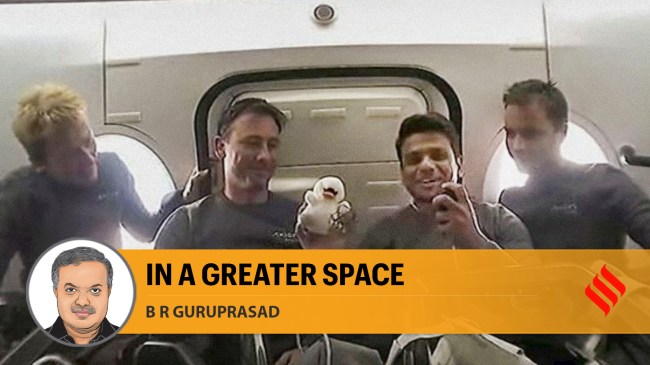Opinion What Shubhanshu Shukla’s Axiom 4 mission will mean for India’s space ambitions
The participation of one of its astronaut candidates in Axiom 4 will enrich Gaganyaan in terms of planning and execution. In this regard, it is pertinent to remember that Shubhanshu Shukla was extensively trained in many US facilities, including at NASA, for about eight months. Fairly detailed knowledge of such facilities as well as the training procedures would not have been available to us without the participation in a human spaceflight mission.
 The sense of excitement associated with spaceflight, especially human spaceflight, and the inspiration it can provide, is immense. It can effectively empower students to pursue STEM education with seriousness. This is one of the prominent benefits to accrue from Shukla’s exciting and worthwhile journey to space.
The sense of excitement associated with spaceflight, especially human spaceflight, and the inspiration it can provide, is immense. It can effectively empower students to pursue STEM education with seriousness. This is one of the prominent benefits to accrue from Shukla’s exciting and worthwhile journey to space. By B R Guruprasad
“The second Indian in space”, Group Captain Shubhanshu Shukla’s return journey to terra firma was safely and successfully accomplished on July 15. Shukla is back after a fruitful stay of about 18 days on the International Space Station (ISS). A day before his return, the Crew Dragon spacecraft ‘Grace’ in which he comfortably sat with his three Axiom 4 colleagues successfully undocked (detached) from the ISS, circling the earth at 400 km height. For the next 22 hours or so, the craft independently orbited the Earth and then dived back into the atmosphere, survived the subsequent fiery re-entry heat and splashed down off the coast of California at a comfortable speed of about 24 km per hour. With this, Shubhanshu Shukla’s maiden sojourn in space concluded.
Understandably, the successful completion of Shukla’s Axiom 4 mission will make the already joyous India more euphoric for quite some time. People across the country, especially students, will be eagerly awaiting Shukla’s return. Many among our hundreds of millions of strong, intelligent and capable students will consider Shukla as a role model. Shukla has said that India’s first space traveller, Rakesh Sharma, was a role model.
The sense of excitement associated with spaceflight, especially human spaceflight, and the inspiration it can provide, is immense. It can effectively empower students to pursue STEM education with seriousness. This is one of the prominent benefits to accrue from Shukla’s exciting and worthwhile journey to space.
Having many significant achievements to its credit in the arena of uncrewed spaceflight, India is confidently and cautiously taking its first step into human spaceflight. Gaganyaan aims to launch Indian space travellers (“gaganyatris”) from Indian soil, in an Indian-built spacecraft, propelled by an Indian launch vehicle, make them orbit the earth for a few days and bring them back safely. Serious and systematic efforts are being led by ISRO, with the enthusiastic participation of many national scientific/technological institutions of repute.
As part of this arduous endeavour, the human rating (significantly enhancing the reliability of a rocket vehicle to safely launch human beings) of India’s most capable launch vehicle, HLVM3, is reportedly completed. The design and development of the Gaganyaan spacecraft, which will be capable of accommodating three space travellers, is in progress. Prashanth Balakrishnan Nair, Ajit Krishnan, Angad Pratap and Shubhanshu Shukla, all test pilots now holding the rank of group captain in the Indian Air Force, have been selected and trained in India and Russia.
The participation of one of its astronaut candidates in Axiom 4 will enrich Gaganyaan in terms of planning and execution. In this regard, it is pertinent to remember that Shubhanshu Shukla was extensively trained in many US facilities, including at NASA, for about eight months. Fairly detailed knowledge of such facilities as well as the training procedures would not have been available to us without the participation in a human spaceflight mission.
Thus, not only the experience of getting trained for the launch, but the first-hand experience of travelling in a spacecraft to Earth orbit has been acquired by Shukla. More importantly, he has gained invaluable experience of living and working in the weightless environment of space aboard the ISS. That he was able to perform the carefully designed and packaged bio-medical, healthcare, space food production and cognitive science-related experiments from India, has greatly encouraged our scientific and engineering community and enhanced our confidence and atmanirbharata. Thus, India’s participation in the Axiom 4 mission is beneficial in many ways indeed.
The writer is Director, Jawaharlal Nehru Planetarium, Bengaluru, Adjunct Faculty, National Institute of Advanced Studies and former Associate Director, ISRO. Views are personal




